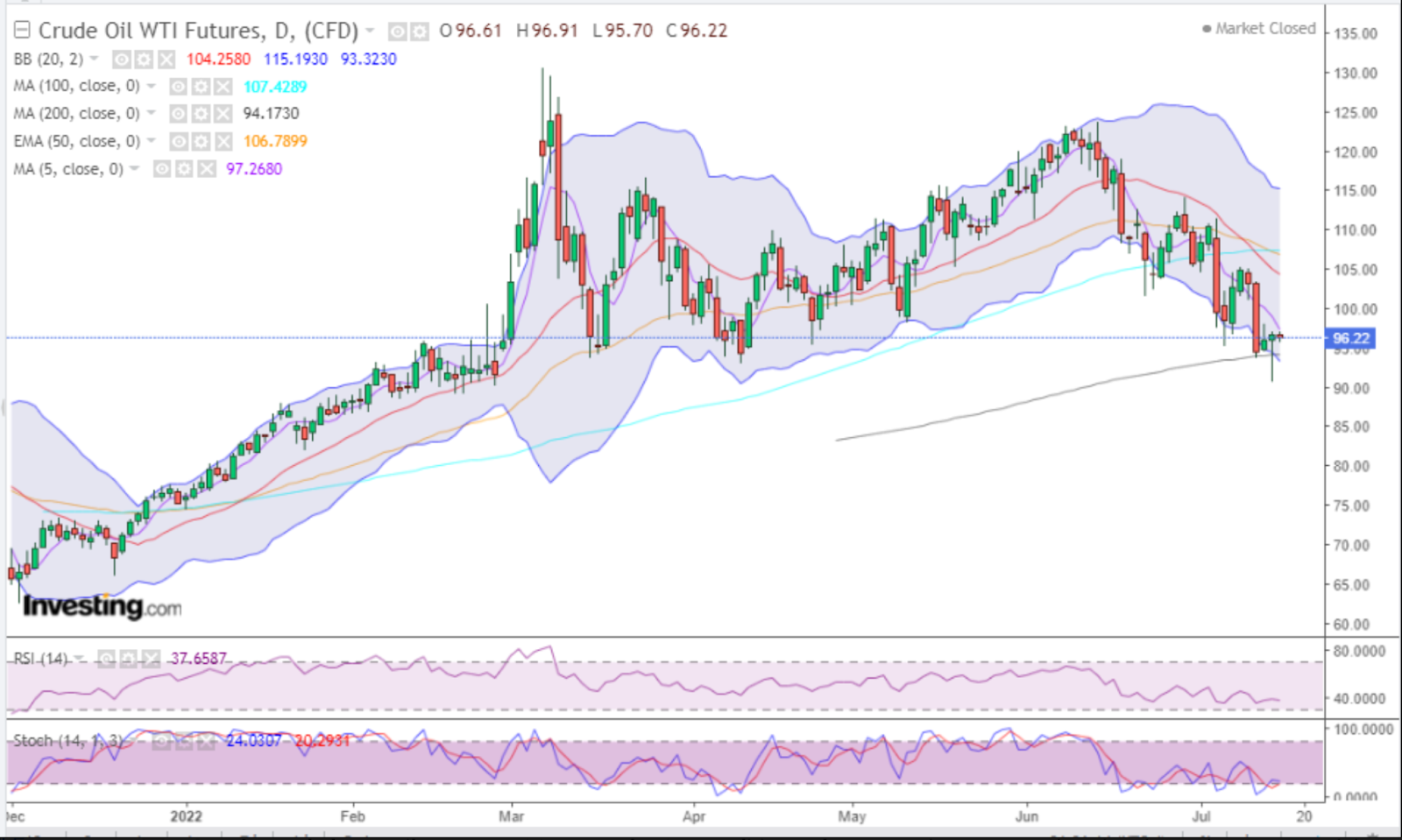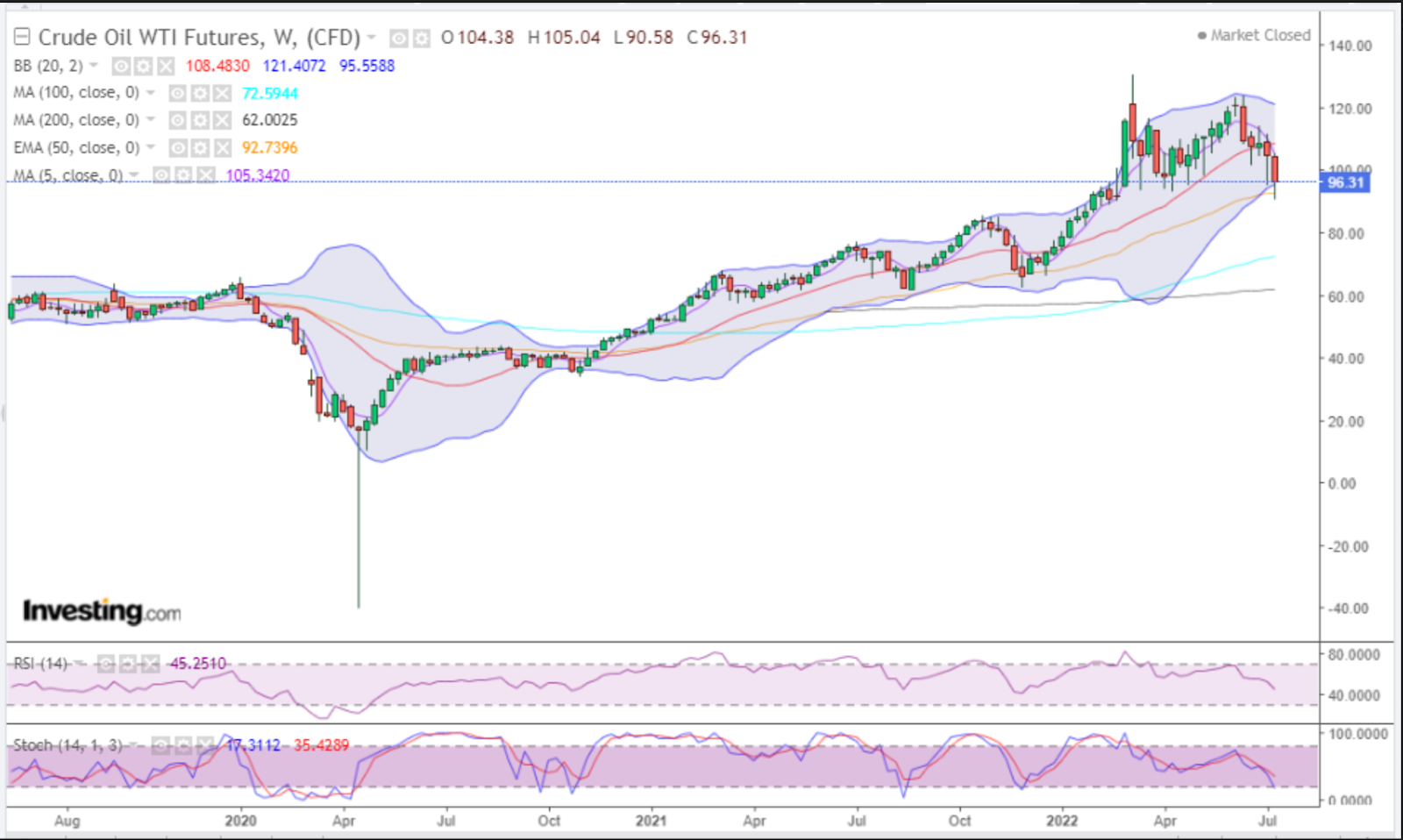Bill Gross warns on gold momentum as regional bank stocks tumble
- June and July have brought sweeping changes to what decides the direction of oil
- Increasingly, oil has become more sensitive to a dollar ramping on threats of aggressive rate hikes by the Federal Reserve and the likelihood of a recession
- This has turned the commodity more into a financial play than one driven just by supply-demand
For the three months that followed the Russian invasion of Ukraine, oil prices virtually went one way: higher. The market was totally biased to the upside from the supply squeeze caused by the Western sanctions on Russia and demand recovering from the COVID shutdowns of 2020/21.
However, that’s looking to change, as June and July have brought sweeping changes to what decides the direction of oil.
Sure, new restrictions on Russian exports or a shipment blockade in Libya or Nigeria can still turn the market on its head, sending crude prices soaring. But increasingly, oil has become more sensitive to a dollar ramping on threats of aggressive rate hikes by the Federal Reserve and the likelihood of a recession if US inflation does not back off from 40-year highs. This has turned it more into a financial play than one driven just by supply-demand.
The narrative in oil now is no longer about barrel deficiency alone. Over the past week, previously unasked questions about whether it had become too pricey and needs to come down meaningfully to lower inflation have come to investors’ attention. Interestingly, all these questions coincide with pump prices of US gasoline that have also started their descent from last month’s record highs of above $5 a gallon.
Stephen Innes, the managing partner at SPI Asset Management, highlighted the change in remarks carried by Reuters:
“Oil is trading very much to the beat of Federal Reserve policy and the implications it could have on both demand destruction and the US dollar.”
He further added, referring to Friday’s morning session for both US crude futures and global oil benchmark Brent:
“With the market falling back to base-case 75 (basis point) hike next week versus 100 (basis point) yesterday, oil prices and the broader market have a little more breathing room today.”
The near parity that financials/technicals have with fundamentals in determining crude prices is a factor investors should keep in mind as President Joe Biden flies to Saudi Arabia on Friday to meet Gulf allies in his bid to make them pump more oil despite OPEC’s capacity constraints.
Another fundamental story taking a backseat in Friday’s market was China’s refinery throughput in June, which shrank nearly 10% from a year earlier. Output for the first half of the year was also down 6% in the first annual decline for the period since at least 2011.
Oil Up Almost 30% On Year, But Also In Bear Market
In Thursday’s trade, New York-traded West Texas Intermediate, or WTI, crude settled at $95.78 per barrel after tumbling to $90.58—its lowest since Feb. 22, or five days before the Ukraine invasion. London-traded Brent crude settled at $99.10 a barrel after plunging to $94.52, its lowest since Feb 21.
WTI and Brent are still up about 28% on the year. But the US gauge is also down 16% since the end of May, while the global benchmark has lost almost 14%.
More importantly, WTI is already in what would be a bear market after losing more than 20% from its Jun. 14 peak of $123.68. Brent is in a similar position if we compare its current standing to its Mar. 7 high of around $140.
Crude prices rebounded from Thursday’s lows after Fed Governor Chris Waller said the central bank couldn’t overdo rate hikes despite shocking price pressures. Waller said he would support a 75-basis point hike at the Fed’s upcoming Jul. 27 decision on rates, over some market bets for a 100-basis point increase.
The remarks from one of the Fed’s more hawkish members calmed investors who had been on tenterhooks since the Consumer Price Index for the year to June came in on Wednesday at a new four-decade high of 9.1%.
St. Louis Fed President James Bullard, known as a super hawk, also soothed investors by opting for a 75-bps hike in the upcoming Jul. 27 decision on rates.
Yet, both Waller and Bullard said they would be open to more extensive rate hikes if data called for it. Waller said:
“For me, a 75-basis point increase at this meeting puts us to neutral. However, if incoming data over the next two weeks shows that demand remains strong, I would incline toward a bigger rate hike.”
'Neutral' is Fed talk for getting inflation back to its target of 2% a year. Bullard said it was plausible for the Fed funds rate to be “higher than 4% by the end of the year if data continues to come in in an unfavorable way.”
Fed funds rates are currently at a high of 1.75%. With four more rate decisions due before the year-end, there would have to be cumulative increases of 2.25% to get to 4%, with a 100-basis point hike likely anywhere between.
The Fed has managed price growth without implementing excessive rate hikes. But its task of avoiding a recession is becoming harder with each galloping print on inflation.
US gross domestic product already declined 1.6% in the first quarter. A negative second quarter GDP is all that is needed to send the economy into a technical recession.
WTI At Inflection Point: $83 Or Breakout to $106?

Chart by skcharting.com with data from Investing.com
Charts show WTI may be vulnerable to a plunge toward $83 after reaching less than a dollar of breaking the critical $90 support. But it could also surprise the upside, reaching above $106.
Sunil Kumar Dixit, the chief technical strategist at skcharting.com, explains:
“Whether the recovery in the WTI since Thursday’s close sustains or fades will largely depend on prices breaking above the 5-Day Exponential Moving Average of $97.27 or being rejected at the threshold.”
If WTI shows a sustained break above the 5-Day EMA of $97.27, it could further advance to the bullish Daily Middle Bollinger Band of $104.26 and the 50-Day EMA of $106.80.
But failure to breach this level will attract selling towards the 200-Day Simple Moving Average of $94.17 and the 50-Week EMA of $92.70.
Unless WTI manages to break and sustain above $98, its recovery may not last.
Chart by skcharting.com with data from Investing.com
Weekly charting and stochastics also show that further selling can push WTI below Thursday’s low of $90.58 and expose it toward $88-$85-$83 in the week ahead.
Crude strategist Michael Boutros concurred with his blog on DailyFX, saying:
“Critical support rests at $85.61-$88.01 – a region defined by 2013 low, the 100% extension of the yearly decline, and the 61.8% Fibonacci retracement of the December rally. [...] We’re on the lookout for a possible exhaustion low/price inflection into this threshold in the days ahead.”
Disclaimer: Barani Krishnan uses a range of views outside his own to bring diversity to his analysis of any market. For neutrality, he sometimes presents contrarian views and market variables. He does not hold positions in the commodities and securities he writes about.
